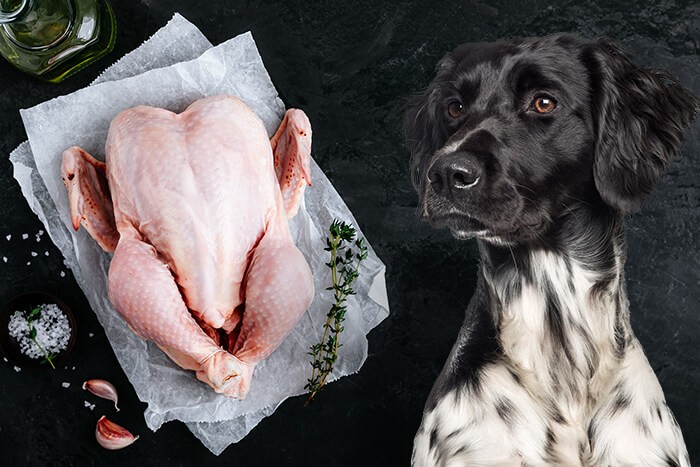Raw chicken meat can be included as part of the canine diet, but dog owners should also beware of its accompanying risks to their pets and themselves. Many vets warn that raw meat has a high chance of carrying animal-to-human transmissible harmful bacteria.
This article will help you better decide whether including raw chicken as part of your dog’s diet is safe and beneficial.
Potential Health Concerns
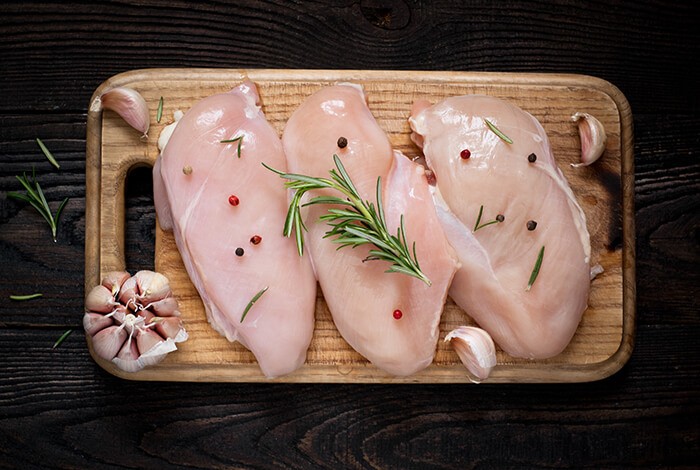
Allergic Reaction
Chicken is one of the most common causes of dog allergies, including egg, dairy, fish, lamb, pork, rabbit, and soy. So when you feed your dog raw chicken for the first time, give it in small quantities. This is to avoid causing a severe allergic reaction if it turns out that he’s allergic to chicken.
Check your dog for any signs of allergic response after eating. These may include itchiness, vomiting, diarrhea, lethargy, and inflamed skin. Note that these symptoms may take about eight to twenty-four hours to show up. Take your pooch to the vet right away once he exhibits these symptoms.
Bacterial Contamination
This is one of the biggest fears that some pet owners have when it comes to the raw diet. Vets have warned that harmful bacteria such as salmonella, E. coli, and campylobacter can quickly spread in raw meat, which is the main ingredient in raw dog food. Moreover, these bacteria can not only be acquired by dogs but humans also.
It is important to point out that healthy dogs with strong immune systems have fewer chances of getting foodborne illnesses from these bacteria. Unfortunately, we, humans, are actually more susceptible than our furry friends.
It is believed that it is due to their canine physiology. Dogs have slightly shorter digestive tracts than we do. They possess stronger stomach acids and have different healthy bacteria in their digestive systems compared to us. These factors may have helped in protecting them from acquiring bacterial infections and digestion problems.
On the other hand, puppies, elderly dogs, and immunocompromised pooches are highly susceptible to diseases from raw food. Since they have weak or underdeveloped immune systems.
A dog that has eaten raw chicken contaminated with bacteria will show the following symptoms:
- Mild fever
- Stomach pains
- Appetite loss
- Salivation
- Vomiting
- Nausea
- Diarrhea
- Dizziness
- Whimpering
Get your dog checked by the vet if he shows any of these signs. To lessen the risk of salmonella poisoning and other food-borne diseases. Choose fresh raw chicken and go for organic or free-range chicken that is not pumped with additives and antibiotics, making it a healthier option.
Imbalance in Omega Fatty Acids
Chicken has two types of omega fatty acids: omega-3 and omega-6. Each serves different functions in the body. Omega-6 fatty acid produces hormones that encourage inflammation. It sounds alarming, but it is a natural and essential part of your dog’s immune response.
Meanwhile, omega-3 fatty acid does the exact opposite of its counterpart. It produces hormones that reduce inflammation. There should always be a balance of the two acids to ensure that your dog’s body is in a healthy state.
The concern about raw chicken is that most of the time, it contains significantly higher amounts of omega-6 fatty acids. This imbalance can cause chronic inflammation. In turn, this can result in chronic diseases such as arthritis, allergies, and diabetes.
With this in mind, always remember to feed moderately. 5:1 is the appropriate ratio of omega-3 and omega-6 fatty acids. Raw chicken should not make up more than a quarter of your dog’s diet.
Is raw chicken good for dogs?
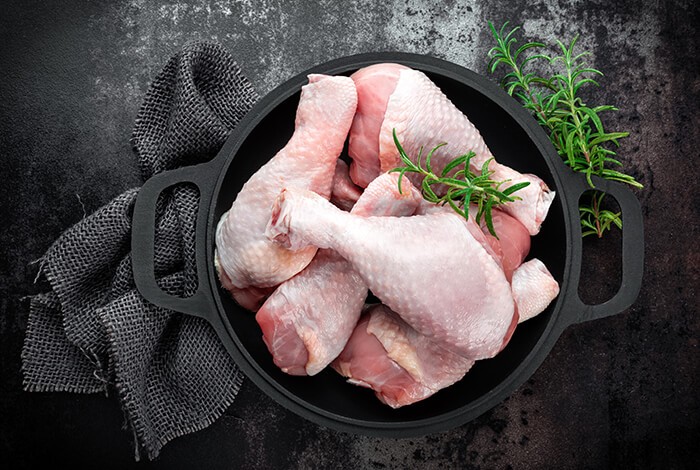 The nutritional content of chicken is altered or reduced when cooked. That’s why some pet owners choose to serve the chicken raw to their dogs. Raw chicken for dogs is a great source of protein.
The nutritional content of chicken is altered or reduced when cooked. That’s why some pet owners choose to serve the chicken raw to their dogs. Raw chicken for dogs is a great source of protein.
There are a handful of vitamins and minerals in raw chicken too. It has vitamin B3, vitamin B6, phosphorus, and selenium. These help in maintaining your dog’s health by:
- providing additional energy
- supporting muscle and body tissue building
- helping in red blood cell formation
- activating B vitamins in the body
- maintaining proper immune system function
- keeping teeth and bones in good condition
- regulating the thyroid hormones
Although raw chicken has a lot of health perks for your pooch, get professional advice first before adding it to his diet. Every dog has different nutritional needs depending on its age, health conditions, etc. You need to ensure that whatever new human foods you want to include in his meals are healthy and suitable for him.
Can dogs eat raw chicken bones?
Do not feed your dog raw chicken bones. Cooked chicken bones are an even bigger no-no. These are very dangerous as they can splinter into small sharp pieces. They can severely damage your dog’s stomach and mouth.
Because chicken bones are hard to chew and digest, they can cause choking and intestinal obstruction too. When preparing raw chicken, always debone it completely to avoid accidents.
Can dogs eat raw chicken necks?
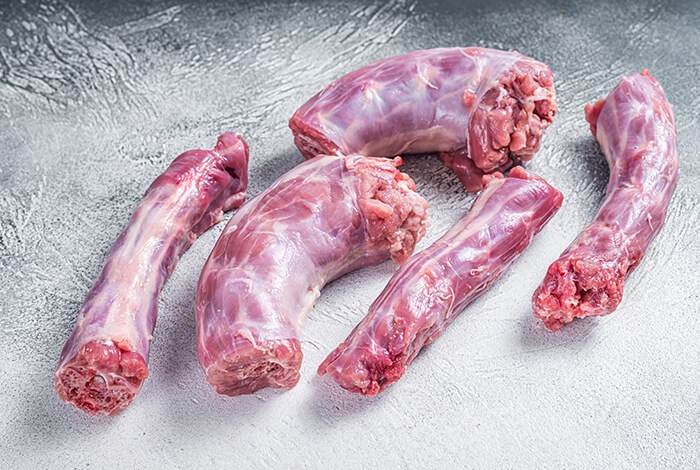 Feeding raw chicken necks to dogs is a bad idea, especially if your dog is not on a raw diet. The size and shape of the chicken neck bones can make them easily get stuck in the dog’s windpipe, causing pooches to choke. Small dogs are particularly at high risk of this danger.
Feeding raw chicken necks to dogs is a bad idea, especially if your dog is not on a raw diet. The size and shape of the chicken neck bones can make them easily get stuck in the dog’s windpipe, causing pooches to choke. Small dogs are particularly at high risk of this danger.
Can dogs eat raw chicken liver?
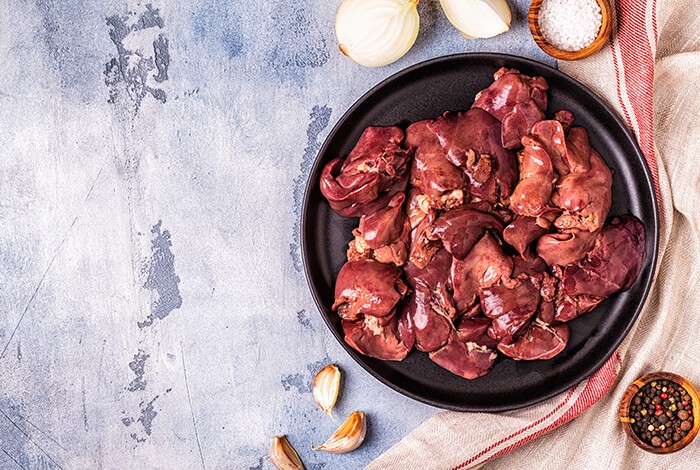 Dogs can eat raw chicken liver. Raw chicken liver is an excellent source of vitamins A, B, B1, B12, and K. It also contains several minerals such as cobalt, manganese, molybdenum, and selenium. This makes raw chicken liver a good supplement to your dog’s diet.
Dogs can eat raw chicken liver. Raw chicken liver is an excellent source of vitamins A, B, B1, B12, and K. It also contains several minerals such as cobalt, manganese, molybdenum, and selenium. This makes raw chicken liver a good supplement to your dog’s diet.
But there are a few exclusions. Since this organ meat is high in fats, it is not recommended for obese dogs and dogs with pancreatitis.
Feed it to your dog sparingly to avoid unhealthy weight gain and the risk of hypervitaminosis A (vitamin A overdose). Limit serving raw chicken liver to once or twice a week.
Can dogs eat raw chicken feet?
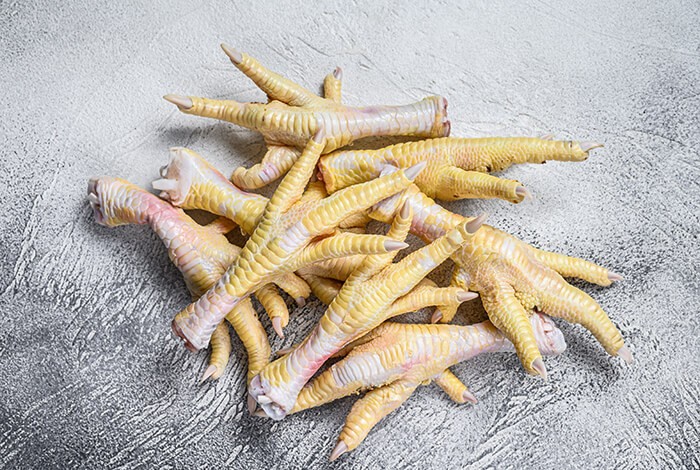 Raw chicken feet are okay for dogs to eat. They contain glucosamine, which is good for dogs’ joints. Some dog owners may be concerned with the bones of chicken feet. There’s no need to worry as they are crunchy and crumbly, unlike other bones.
Raw chicken feet are okay for dogs to eat. They contain glucosamine, which is good for dogs’ joints. Some dog owners may be concerned with the bones of chicken feet. There’s no need to worry as they are crunchy and crumbly, unlike other bones.
Instead of splintering, they get crushed when they’re munched on. Thus, they are not harmful to your dog’s mouth and digestive tract.
Before your dog eats chicken feet, make sure to snip off the nails. They are quite sharp and may injure his mouth.
Feed raw chicken feet to your dog in moderation. Obese dogs and dogs suffering from pancreatitis are not advised to be given raw chicken feet.
How to safely feed raw chicken to dogs:
Here are a few reminders when preparing raw chicken for your dog:
- Consult the vet first before incorporating it into your pooch’s diet. They will determine if it meets your dog’s nutrition needs.
- Consider purchasing fresh, organic, free-range chicken. It is low in antibiotics and additives than regular chickens.
- Wrap the raw chicken in a foil or plastic bag before storing it on a low shelf of the fridge. Never leave it out at room temperature as bacteria can quickly proliferate.
- Always keep your dog’s food and water bowls clean and sanitized. Wash them after feeding your dog to avoid bacteria from thriving on their surfaces.

